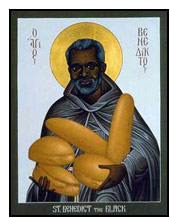by Father Anthony Vader
The three elements of African-American worship I will present are
not exclusive to African-American tradition, but all of them are
highlighted in this worship.
Celebration
The African-American concept of celebration demands ornateness. African-Americans
dress up for Sunday liturgy. After many years with African-American
worship congregations, I am no longer at ease with those Masses in
some white parishes where some of the parishioners worship while
wearing
T-shirts, slacks, and sweatshirts. African-Americans would
never dress so informally to celebrate with the Lord.
When they were forbidden because of prejudice to enter public gathering
places, African-Americans isolated themselves to avoid conflict with
prejudiced persons. This isolation could have been disastrous to
their personalities. To restore their self-dignity they wore beautiful
clothes symbolizing their inner worth. Their churches were places
where they could wear stunning clothes, so dressing for the Lord
had two purposes. Today African-Americans can enter any restaurant,
hotel, or other assembly dressed as they want, and yet they still
dress for the Lord. After all, they want to thank God that they can
afford these clothes.
The priest who greets his well-dressed parishioners in his clergy
shirt (no coat or cassock),  baggy trousers, and unshined shoes lets
his parishioners know that he has not identified with them in this
aspect of their subculture. Black ministers always wear their gowns
on Sunday, and some of them have put on lace surplices and even birettas.
One minister in the neighborhood has his deacon wrap him in a cardinal’s
water-silk cape after the Sunday sermon.
baggy trousers, and unshined shoes lets
his parishioners know that he has not identified with them in this
aspect of their subculture. Black ministers always wear their gowns
on Sunday, and some of them have put on lace surplices and even birettas.
One minister in the neighborhood has his deacon wrap him in a cardinal’s
water-silk cape after the Sunday sermon.
Vestments should reflect
the grandeur and the glory of God in design, color, and fabric. If
the parish is poor, special collections for this purpose will cause
people to empty wallets and purses. If the pastor allows
the women of the parish to purchase the materials and do the sewing,
as African-American women have been doing for years, he will be proud
of himself and his Sunday liturgy. The same is true for the sanctuary
and those who are in the sanctuary for the Eucharist. Expertly trained
and disciplined altar servers (plenty of them), dressed in joyful
and stately robes reflecting their status at the altar, add to the
grandeur of the worship service. To reflect the glory of God and
the worship service, bells, incense, holy water, banners, and perhaps
dancing should be incorporated. All creation sings the praise of
God.
Music
African-Americans come from a great tradition of liturgical singing.
Their spirituals are often considered America’s finest contribution
to the fine arts; but long before they were so recognized, the spirituals
were a source of strength to the African-American slaves. Gospel
music (and its secular counterpart, the Blues) grew out of the roots
of the spirituals and African music. Great African- American singers
have filled churches, opera houses, and auditoriums in both the United
States and Europe; and a popular part of their concerts has been “black” music.
An African-American congregation sings and sways when the organ and
the piano softly introduce familiar music after a scripture reading,
a homily, or Holy Communion. This is a model for all Catholic worship.
African-American churches have a tradition of great
choirs. People join church choirs for many reasons, but principally
to praise God through the talent God gave them. Choirs also encourage
congregational involvement by participation and appreciation. The
minister of music who knows good music, and who also knows where
the congregation is musically, can combine choir and congregation
in an emotionally moving unity. And a good choir can keep the scripture
reading or the homily in our minds for the rest of the day because
music continues to stir us.
The non-Catholic African-American visiting a Catholic church is anxious
because of all the standing, kneeling, etc. and can find consolation
when the choir begins to sing a familiar Gospel hymn or spiritual.
Music soothes, and familiar music is especially comforting, as any
mother with an upset child will testify.
I do not intend to denigrate traditional music, some of which goes
back to the earliest days of Catholicism. Even African-Americans
warn Catholic choirs against singing only spiritual and Gospel music.
Many converts have said that they came to Catholicism out of reverence
for Catholic worship. They could have stayed in their Baptist, Methodist
or Pentecostal denominations if they wanted Baptist, Methodist or
Pentecostal religious services. African-American choirs often present
Bach masses, Palestrina motets, and other neglected Catholic music.
Like the great African-American concert and operatic artists, all
choirs should produce a varied program of many musical styles to
praise God. These choirs appreciate what we Catholics neglect. Spiritual
and Gospel music becomes Catholic music on a par with traditional
Catholic music for all the members of a church.
Three admonitions to parishes that include African-Americans are
also lessons for any parish. First of all, choirs, whether African-American
or white, whether Gospel or traditional, have a habit of not wanting
to end their selection. Instead of competing with each other, the
priest and choir work together to glorify the Lord.
Second, African-American choirs sway to the music and clap their
hands. They (and the congregation) cheer a good soloist or a moving
rendition of a favorite hymn. Most white congregations are more sedate.
Good music “moves” the hearer, who has to show involvement
and participation through body language.
Finally, musicians and music are expensive. The good African-American
organist, pianist, and music director are on a “wanted” list
for both Catholic and Protestant churches. If a parish thinks it
can be cheap with regard to music in their annual budget, the parish
suffers. Churches with decreasing congregations should examine their
music programs.
By skimping on the music budget, a congregation often dwindles,
and the collection decreases. African-American Protestant churches
often take up the collection during the choir’s most moving
musical selection. Parishes on subsidy from the diocese should petition
as much money for their music ministry as needed. A good choir can
enlarge a congregation and get a parish off diocesan subsidy.
Preaching
Few and far between are the white preachers who can preach in an
African-American style. Anyone who has heard the great African-American
preachers, with their use of alliteration, familiar stories, and
especially their ability to excite a congregation after a few well
chosen sentences, can only envy their skill. I fear that copying
their style would be foolish.
African-American religion is associated with the Protestant tradition
in which sacraments are not stressed. Prayers and preaching supported
by music became the foundation of the African-American worship service.
The preachers had to be proficient just to maintain their churches.
Up to the 1960s, just about all intelligent, educated, and skilled
African-Americans had only one profession—the ministry—in
which they could exercise their talents and charisma. For the great
number of African-American men and women who went to seminaries,
preaching was of primary importance.
All good preaching should involve the emotions. Whatever excites
us moves us totally, including our emotions. African-American preachers
are not more convinced of the power of God’s word and message
than white preachers, but they preach with more conviction. African-American
preachers work harder on their sermons: the stories, the chanting,
and the outpouring only seem spontaneous. Their sermons also last
longer; and so the ideas, mechanics, and interaction with the congregation
have to be worked out better.
Those who have listened to African-American preachers for a long
time know that the final product is a message of consolation and
strength for the congregation.
(Reprinted and revised from Parish Liturgy,
October-December, 1996, pp. 5-6)

 baggy trousers, and unshined shoes lets
his parishioners know that he has not identified with them in this
aspect of their subculture. Black ministers always wear their gowns
on Sunday, and some of them have put on lace surplices and even birettas.
One minister in the neighborhood has his deacon wrap him in a cardinal’s
water-silk cape after the Sunday sermon.
baggy trousers, and unshined shoes lets
his parishioners know that he has not identified with them in this
aspect of their subculture. Black ministers always wear their gowns
on Sunday, and some of them have put on lace surplices and even birettas.
One minister in the neighborhood has his deacon wrap him in a cardinal’s
water-silk cape after the Sunday sermon.